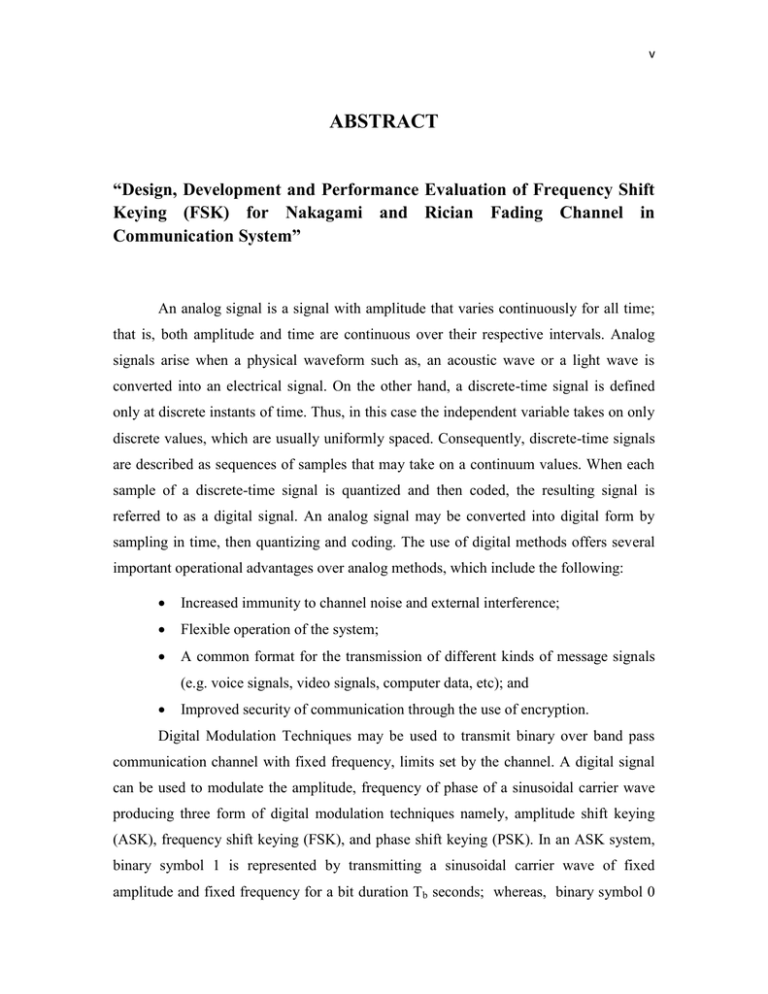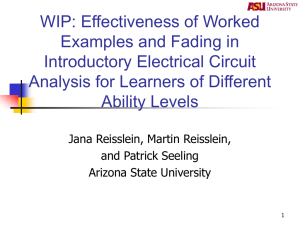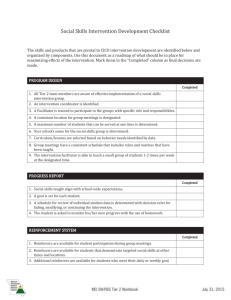abstract - Shodhganga
advertisement

v ABSTRACT “Design, Development and Performance Evaluation of Frequency Shift Keying (FSK) for Nakagami and Rician Fading Channel in Communication System” An analog signal is a signal with amplitude that varies continuously for all time; that is, both amplitude and time are continuous over their respective intervals. Analog signals arise when a physical waveform such as, an acoustic wave or a light wave is converted into an electrical signal. On the other hand, a discrete-time signal is defined only at discrete instants of time. Thus, in this case the independent variable takes on only discrete values, which are usually uniformly spaced. Consequently, discrete-time signals are described as sequences of samples that may take on a continuum values. When each sample of a discrete-time signal is quantized and then coded, the resulting signal is referred to as a digital signal. An analog signal may be converted into digital form by sampling in time, then quantizing and coding. The use of digital methods offers several important operational advantages over analog methods, which include the following: Increased immunity to channel noise and external interference; Flexible operation of the system; A common format for the transmission of different kinds of message signals (e.g. voice signals, video signals, computer data, etc); and Improved security of communication through the use of encryption. Digital Modulation Techniques may be used to transmit binary over band pass communication channel with fixed frequency, limits set by the channel. A digital signal can be used to modulate the amplitude, frequency of phase of a sinusoidal carrier wave producing three form of digital modulation techniques namely, amplitude shift keying (ASK), frequency shift keying (FSK), and phase shift keying (PSK). In an ASK system, binary symbol 1 is represented by transmitting a sinusoidal carrier wave of fixed amplitude and fixed frequency for a bit duration Tb seconds; whereas, binary symbol 0 vi is represented by switching off the carriers for Tb seconds. In an FSK system, two sinusoidal waves of the same amplitude but of different frequencies are used to represent binary symbol 1 and 0 respectively. In a PSK system, a sinusoidal carrier wave of fixed frequency and amplitude is used to represent both symbol 1 and 0, except that the carrier phase for each symbol differs by 1800. Digital Modulation Techniques may be classified into coherent and non-coherent techniques. The coherent detection of binary PSK is similar to that of ASK. PSK cannot be detected non-coherently like ASK. Modified PSK generation schemes are differential phase shift keying (DPSK), double differential phase shift keying (DDPSK), quadrature phase shift keying (QPSK), and quadrature quadrature phase shift keying (QQPSK). A signaling technique that combines differential encoding with phase shift keying is known as DPSK. QPSK is an extension of binary PSK. It is the example of M-ary data transmission with M=4 in QPSK; one of four possible signals is transmitted during each signal interval with each signal uniquely related to a bit. Except these keying, we have minimum shift keying (MSK), M-ary FSK (MFSK), and non-coherent FSK (NFSK), etc. The multipath propagation model for the channel, embodied in the received signal, results in signal fading. The fading phenomenon is primarily a result of the time variations in the phases. The amplitude variations in the received signals and termed signal fading are due to the time variant multipath characteristics of the channel. When the impulse response is modeled as a zero-mean complex valued Gaussian process, the envelope at any instant time is Rayleigh distribution. In this case the channel is said to be Rayleigh fading channel. In event that there are fixed scatterers or signal reflectors in the media, that is impulse response, can no longer be modeled as having zero mean; in this the envelope has a rice distribution and the channel is said to be Rayleigh fading channel, An another probability distribution function that has been used to model the envelope of fading signal is the Nakagami distribution. There are two types of combining techniques - maximal ratio and equal gain. Every diversity scheme can be applied to one of these combining techniques. They are with a two branch diversity receiver. Equal-gain combining is a co-phase combining that vii brings all phases to a common point and combines them. The combined signal is the sum of the instantaneous fading envelopes of the individual branches. Equal-gain combining has only one dB degradation as compared to maximal-ratio combining. Because of this and because the circuit is relatively simple, equal-gain combining is usually used at base stations. The term “maximal ratio” refers to maximal signal-to-ratio. This is the best combining technique, Each branch needs proper weights. At a base band, the combined signal is the sum of the instantaneous SNRs (γi) on the individual branches. The performance of maximal-ratio combining is shown in where Г is the average SNR of a signal channel, Г = (γi). This combining technique for a two-branch diver needs two receivers the circuit become is very complicated. The performance of post detection combiners for non-coherent detection of FSK signals over Nakagami and Rician fading channel with an arbitrary covariance matrix and real distinct fading parameters may be improved. The problem in the characteristics function domain has been tackled in terms of differentiation. The efficient technique to simplify the error performance calculation has also been developed. It was revealed that if channel gains remain unchanged over two successive symbol intervals, the error probability of FSK has the same expression as NFSK except that the Г –matrix used for NFSK is replaced by 2 Г for FSK. Without this condition, the error probability of FSK would take a different form. A new suboptimum non-coherent diversity receiver has been proposed for NCFSK signals over no identical Nakagami-m and Rayleigh fading channels. The proposed receiver is basically a square-law receiver with post detection weighted branches. In contrast to that of the square-law receiver, the derived expression for the average BER of the proposed receiver is simple in the sense that it requires negligible computational time, and can be easily evaluated. Moreover, it does not involve any numerical integrations or special functions, and is directly expressed in terms of the average SNRs and fading parameters. It has been shown that this receiver has the potential of eliminating the non-coherent combining loss, which is a main problem associated with the conventional square-law receiver especially at relatively low average SNRs. In addition, the proposed receiver does provide improvements over the conventional square-law receiver on the whole range of average SNRs. The optimal viii detection of a desired FSK modulated bit in the presence of another FSK modulated interfering signal and additive white Gaussians noise was examined. The performance of a receiver which minimizes the BER, when the desired and interfering signal parameters as well as the noise PSD are known, was compared to that of a conventional matched filter receiver. It is observed that this optimal receiver can have a much lower BER when the signal-to-interference ratio is small. The closed form solution developed for the problem was used to study the influence of the fading parameter and the SNR distribution ratios on the error performance. Objectives In mobile communication system, a signal is communicated on different communication channels. Hence, there is always a possibility of interference due to cochannel and adjacent channel communications. The main objectives of the research are as follows. • to help the communication system design through numerical computation to separation of channels; • to help the communication system design through numerical computation to reduce the possibility of interference due to co-channel and adjacent channel • to help the communication system design through numerical computation to reduce the path-loss; and • to help the communication system design through numerical computation of Reliability in term of probability of error which are important parameters in mobile radio environment. covariance matrix and real distinct fading parameters. The research work, therefore, would try to identify and establish the error performance of post detection combiners for non-coherent detection of FSK signals over Nakagami and Rician fading channel with an arbitrary covariance matrix and real distinct fading parameters. ix Methodology: The methodology adopted for the present study is as follow: Literature survey on Design, Development and Performance Evaluation of Frequency Shift Keying (FSK) for Nakagami and Rician Fading Channel in Communication System. Study of these materials to know the present developments in the area. Identification of pertinent parameters related to Nakagami and Rician fading channels. Study of formulae/derivation to know inter-relationship among the different pertinent parameters related to Nakagami and Rician fading channels. Use of formulae/derivation for the evaluation of pertinent parameters related to Nakagami and Rician fading channels. Use of simulation (MATLAB) to co-relate these pertinent parameters related to Nakagami and Rician fading channels. Performance evaluation and analysis of obtained simulation results to know the effects of these pertinent parameters on Nakagami and Rician fading channels. Design and Development of Frequency Shift Keying (FSK) for Nakagami and Rician Fading Channel in Communication System using Simulink The Organization of Thesis Chapter I: The very first chapter of the research work overviews the organization of the whole study by introducing the very existence of word communication and its different aspects. At the same time, it elaborates the objective and scope of research on “Design, Development and Performance Evaluation of Frequency Shift Keying (FSK) for Nakagami and Rician Fading Channel in Communication System”. The chapter also tries to explain the x organization of the thesis and the methodologies through which the research work is carried out Chapter II: This chapter gives a detail idea on the available literature on “Design, Development and Performance Evaluation of Frequency Shift Keying (FSK) for Nakagami and Rician Fading Channel in Communication System”. The chapter consists of basic communication system, its history, element and types; analog and digital communication, multichannel digital communication; fading channel characterization modeling of flat fading channels and frequency selective fading channels; diversity technique and combining technique for diversity schemes; non-coherent communication in AWGN; coherent and non-coherent binary frequency shift keying. Chapter III: The second chapter deals with Nakagami - m Fading Channel with Noise and Interference for NFSK System. The performance of digital communication systems are perturbed by Adoptive White Gaussian Noise (AWGN), multipath fading and co-channel interference. Analysis of the performance of digital communication on fading channels in presence of noise and interference is of considerable interest of theoretical as well as practical research. The diversity techniques for digital communication have been over Rician fading and Nakagami fading channels in presence of a single as well as large number of interferers described in detail and reference therein using optical combining technique. The effect of co-channel interference and noise on the bit error probabilities in amplitude shift keying ASK and binary phase shift keying BPSK have been explained through explicit expression of signal to interference plus noise ratio (SINR). The closed form expression for bit-error probability of BPSK for asynchronous interference in Ricial fading environment is presented by Hamdi. The outage probability in Nakagami fading channel under Rician interference is studied by Paris and Jimenez. In all the above studies, they have considered the interferences with the noise background. The derivation of closed form expression for probability of error is quite complicated and approximate. xi Hence, in this chapter, the performance evaluation of FSK and effect of noise and interference on Nakagami fading channel, FSK signal is considered independently at the receiver. Chapter IV: This chapter deals with Exact Analysis of non-coherent FSK system with square law combining our Nakagami-m fading channel. Here, NMFSK has been considered with square law combiner and L-diversity for Nakagami channels. It has been attempted to derive the general solution for NMFSK for Nakagami fading channels for symbol error probability for complex additive white Gaussian noise (AWGN) with zero mean different variances. The total SNR has been considered and different average SNR for different branches at the output of combiner. The organization of chapter is as follows: section 2nd contains the formulation of problem. Section 3rd contain the derivation of closed form expression for SEP. Result and discussion are shown in section 4th. Finally, the conclusion of the chapter is presented in section 5th. Chapter V: This section of the research work explores Performance of BFSK System over Rician fading channel with Doppler spread by implementing the different modulation techniques over various channels (AWGN channel, Rayleigh channel, Rician channel), the presence at Doppler shift in faded increase the probability of error. By observing from figure (2), one can see that the probability of error decrease with signal to noise ratio (SNR) for each value of L. The probability of error decreases as the value of L increase at a particular as the value of SNR. The decrease of Pe for L=5 is minimum and fast. Whereas, the different values frequency deviation fDT = 0.08 and 0.240 for L = 3 is shown by plotting the relation between probability of error Pe computed and plotted in figure (3). Here, the probability of error decrease with SNR for both values, frequency deviation, initially, Pe for fDT = 0.08 slightly different from fDT = 0.24 but for SNR > 10. Here, Pe in both cases is the same. The presence of Doppler shift in a faded channel increase the probability of error. The increase in the probability of xii error depends on frequency deviation. As frequency deviation decrease, the probability of error increases. Chapter VI: In mobile communication system a signal is communicated on different communication channels. There is possibility of interference due to cochannel and adjacent channel communication. Thus, mobile communication system becomes interference limited together with noise limited. So the study of communications on fading channels in noise interference environment is very interesting. Most of the literatures are concentrated on noise limited environment mobile communication. In this study the focus is on the study of mobile communication system in noise and interference limited. Our studies will be helpful in communication system design through numerical computation of separation of channels, path-loss and probability of error which are important parameters in mobile radio environment. This section that is to say Chapter VI of the research work tries to come out with the summarization of the whole study along with some highlighted findings. Error Performance calculations have been performed using an efficient technique. In this technique characteristic function method is employed and closed form solution has been achieved through differentiation. It reveals the fact that if channel gains remain unchanged over two successive symbol intervals, the error probability of FSK has the same expression as NFSK except that the matrix used for NFSK is replaced by 2 for FSK. Without this condition, the error probability of FSK would take a different form. The formulae were then used to study two types of diversity schemes that can be used in a base station - one with linear antenna arrays and the other with triangular arrays. Computer results show that the increase of the diversity order can significantly improve the error performance at the cost of increased antenna site. Properly increasing antenna separation can also help improve the performance. However, when the correlation reaches 0.6, further increasing the separation will basically trade array dimension for the same has been performed with arbitrary covariance matrix and real different fading parameters.


